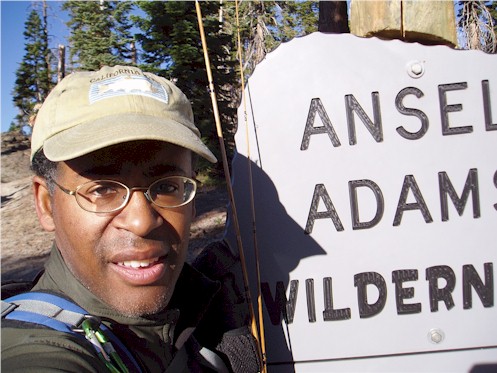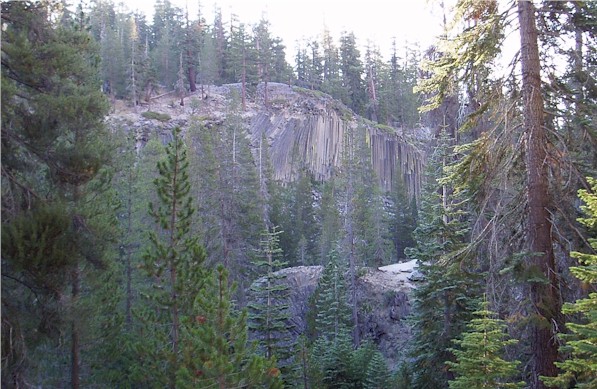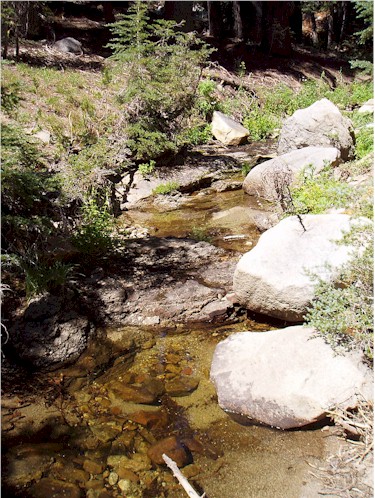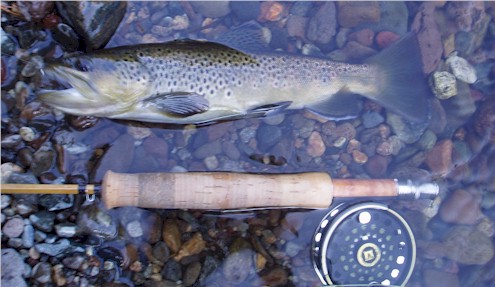|
|
|
|
|
September 9th & 10th - San Joaquin Drainage & Hot Creek
Time:
7:30am - 6:00pm Saturday, 12:00am - 4:00pm Sunday Narrative:
I typically donít like to fish high on streams this time of year, due to the lack of water but the more I thought about a day trip for Paiutes, the more excided I became. The trailhead leaves from the Reds Meadow/Devils Postpile area so I arrived early to allow myself the flexibility of having my car at the trailhead. Devils Postpile is a national monument and all visitors arriving later than 7:00am have to take a shuttle into the valley. The temperatures were in the 30s when I arrived but a warm, clear day was forecast. At the trailhead I met a fellow cane angler and rod maker. He was an older fellow and had been visiting the area for 60 years. He planned to fish the San Joaquin and when we both pulled out cane rods, a rapport quickly developed. He fished an extraordinary 8ft Garrison that he made using titanium components. He was an engineer and I was given the impression that he had machined the components himself over 20 years ago! I donít know if that is correct but he gave me the impression that it had been quite some time since heíd made a rod.
We parted ways and were soon off on our respective adventures. He upstream and me up one of the many trails in this area. Almost immediately I was treated with views of the Devils Postpile. Shortly, I was up the first climb and into a barren waste land of burned trees and pumice. My tracks were easily seen as were the tracks of the bear that had probably come through earlier that morning or sometime the night before. After about an hour I crossed a small stream and headed up, over and around the next mountain. It was quite the slog. Not so much because it was difficult, it wasnít too bad but several times when it looked like I was cresting the top, it turned out I had to keep going. After about 3 hours I finally came to a meadow which signaled that I was close to my final destination. The stream wasnít quite in a valley but the meadow signaled a leveling out of the slope. Once past the meadow I hiked through several dry stream beds. I expected this, itís not unusual to come across dry trails where melting snow once made itís way down to a larger creek and into the main river drainage, in this case, the San Joaquin. Unfortunately, the larger creek never appeared. I suspected this might be the case before leaving and chose the fork of the creek that, at least on the map, held the most water. It did hold the most water but unfortunately, it was not enough to fish.
Not one to be discouraged, I continued down the trail, hoping to come across some semblance of fishable water. It also never appeared and when the trail started to decline significantly into the next valley, I chose to turn around. There was a fishable stream in the valley but I didnít know if it contained Paiute Trout and just as I could have followed the trail, I could have also followed the dry creek to fishable water. Discretion being the better part of valor and having already hiked 4 hours I decided to return to the creek Iíd seen earlier, instead of venturing off into the unknown, the more unknown. At about 3pm I found myself back at the stream crossing. I pumped some water, ate some pop-tarts and then the game was a foot. I tied on an EHC and Adams combination and went to work. I didn't know what sort of fish this stream held. I figured it probably had brook trout and secretly hoped that maybe it had Paiutes. It had brookies but no Paiutes. Instead, it held beautiful Rainbow Trout/ Golden Trout hybrids. I fished for about an hour, catching mostly Golden Trout hybrids but also catching the occasional Brook Trout. The fish were quite particular and preferred the Adams almost exclusively. For a small stream the creek seemed to hold good numbers of fish in respectable sizes. Most of the fish were in the 8 inch range and in an hour I hooked and landed 8. I'm sure I could have found larger fish if I'd simply had time to move up or down from the crossing area. The fish simply seemed healthy. This stream definitely warrants greater exploring.
The trail back to the parking lot was extremely dusty and the wind was at my back. This is a good thing if you are trying to avoid bears but it's a bad thing if you happen to be descending a mountain without a mask. As I made my way down, my speed and the wind were timed such that the pumice I kicked up saturated my lungs. Try as I might, I couldn't help but breath in the fine particles of dust; this triggered an asthma attack which was fairly incapacitating until I reached my hotel and my wife's bottle of albuterol . In the future, I will always bring a mask....and a bottle of albuterol.
The asthma would happen later and the hour between my asthma attack and reaching the trailhead, I fished the San Joaquin. Yet to realize my lungs were closing up. I cast away happily to the occasionally rising trout. I understand now why a friend of mine fishes the San Joaquin in the fall. The stream must have some large spawning brown trout.
Sunday I fished Hot Creek and boy was it crowded. Fishing was fair and the only entertainment for the day was watching a guide work his magic with two clients. Two of the actions of the guide surprised me somewhat. First was that his clients were fishing San Juan worms and absolutely hammering the water. We're talking 40 minutes in one spot type of hammering. The second is that he actually had his clients wading the stream. I'd always thought and read that one shouldn't wade Hot Creek due to the fragile nature of the vegetation (and the anglers ticked off down stream when you start kicking up weeds). It's interesting to note that someone who makes his living off the river had his clients actually in the water in the middle of the stream. It's also interesting to note that this didn't seem to help much... although I have witnessed other wading folks making a killing by being able to get the greater line control that comes with less distance.
Admittedly, I too was hammering the water more than I usually do. I'm not quite sure why but it meant that I didn't catch as many fish as I normally do. On Hot Creek I always feel I can nymph up at least one fish at every good spot. If I don't move to those spots, I don't catch fish. I did manage to land several nice fish but more often LDRed the really nice ones. This was happening so often that I simply laughed each time a fish went scurrying away.
Previous Yosemite / Ansel Adams Wilderness Chronicle Next Yosemite / Ansel Adams Wilderness Chronicle
|

 Iíd
planned to fish one or both of these streams this year. Originally, having
looked at a map last year, Iíd planned a 4 day backpacking trip into the
stream that I felt was most accessible. Unfortunately, a family emergency
prevented me from going on that trip, so as a consolation; I planned a day
trip into the other stream. Iíd originally thought that both streams would
require a multi day trip and some bush whacking. That made sense to me as
the idea from what Iíd heard was to plant the fish in remote streams.
However, earlier this year, a fellow mentioned to me that there was a
shortish trail (~ 5 miles) that crosses the upper reaches of the stream. I
hadnít noticed this and in fact, not all of my maps showed the trail
actually crossing the creek.
Iíd
planned to fish one or both of these streams this year. Originally, having
looked at a map last year, Iíd planned a 4 day backpacking trip into the
stream that I felt was most accessible. Unfortunately, a family emergency
prevented me from going on that trip, so as a consolation; I planned a day
trip into the other stream. Iíd originally thought that both streams would
require a multi day trip and some bush whacking. That made sense to me as
the idea from what Iíd heard was to plant the fish in remote streams.
However, earlier this year, a fellow mentioned to me that there was a
shortish trail (~ 5 miles) that crosses the upper reaches of the stream. I
hadnít noticed this and in fact, not all of my maps showed the trail
actually crossing the creek.


